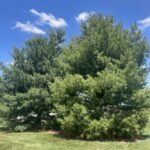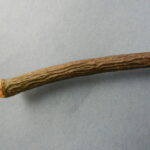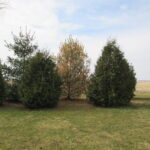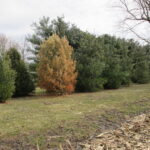I think white pines are beautiful trees, especially at maturity, and they have the added advantage that they are one of the few conifers that don’t try to kill you with their needles. Besides working with the foliage, have you ever had to “rescue” a child who climbed too high in a spike-infested deathtrap of an evergreen? Did you develop the rashes to prove it? Not with a white pine!
My kids haven’t had the chance to climb a mature white pine. Many seem to decline at about 15-20ft. We have been describing this issue as white pine decline, but it isn’t entirely easy to explain. There are a number of factors that influence overall plant health and that can contribute to plant decline, but let’s focus on white pines here. White pine decline is typically attributed to root stress that can be caused by or exacerbated by high soil pH (chemically unavailable nutrients), heavy soil texture (clays), compaction, and excessive soil moisture.
Anything that affects the roots can affect the overall health of the tree, so if the roots are compromised and they cannot uptake water or nutrients, the tree will decline due to lack of nutrients or even lack of water. Needles on an affected tree will turn yellow and eventually brown and fall off prematurely (Figure 1). A symptom of white pine decline includes stems that have shriveled or desiccated bark because roots are not functioning properly cannot pull in enough water (Figure 2).
Depending on the severity of the root conditions, trees may take several years to decline and die, but with significant root stress, trees will decline faster. I have been seeing a lot of white pine yellowing around West Lafayette and in Indianapolis over the last year and a half and I think the odd environmental extremes have not been helping. Cycling between prolonged drought and torrential downpours lead to stress that can have lasting effects that could take years to recover from, or might be the final nail in the coffin.
There is nothing that can be done to recover from or stop decline once symptoms are observed in white pine. However, taking an approach to actively mitigate stress can help extend the life of white pine trees that are currently healthy. In many cases, one white pine will decline while other trees in the vicinity appear healthy (Fig 3, 4). Removal of symptomatic trees is important because stressed trees often attract bark beetles which can spread to the remaining healthy trees.
Another point: not every tree is going to respond the same way at the same location. Stress factors, such as a poor root system when planted, planting too deeply, or even Phytophthora root rot may have predisposed one tree to decline more than others. Just because one tree goes down doesn’t mean they all will, so keep an eye on the others and try to improve the site conditions where practical.
For more information on white pine decline, please see the following link: https://www.extension.purdue.edu/extmedia/BP/BP-34-W.pdf
For information on wood and bark boring beetles of pines and other conifers, please see the following link: https://www.purduelandscapereport.org/article/beat-back-borers-attacking-pines-and-other-cone-bearing-trees/
https://www.youtube.com/watch?v=OoQtAYrNwAo&list=PLgavttJPLt2QF5ZEUzGfA5hg2qSOdiT2c&index=5
- Figure 1: Image: 23-00643 White Pine_001 Text: Two white pines planted in the landscape; one is developing a general chlorotic appearance.
- Figure 2: Image: 17-00382 White Pine_02bark Text: White pine showing symptoms of decline on branches where the bark is shriveled and sunken.
- Figure 3: Image: 15-00086 White Pine_08 Text: A singular white pine amidst a windbreak showing symptoms of white pine decline.
- Figure 4: Image: 15-00086 White Pine_11 Text: View same tree from the other side of the windbreak.



